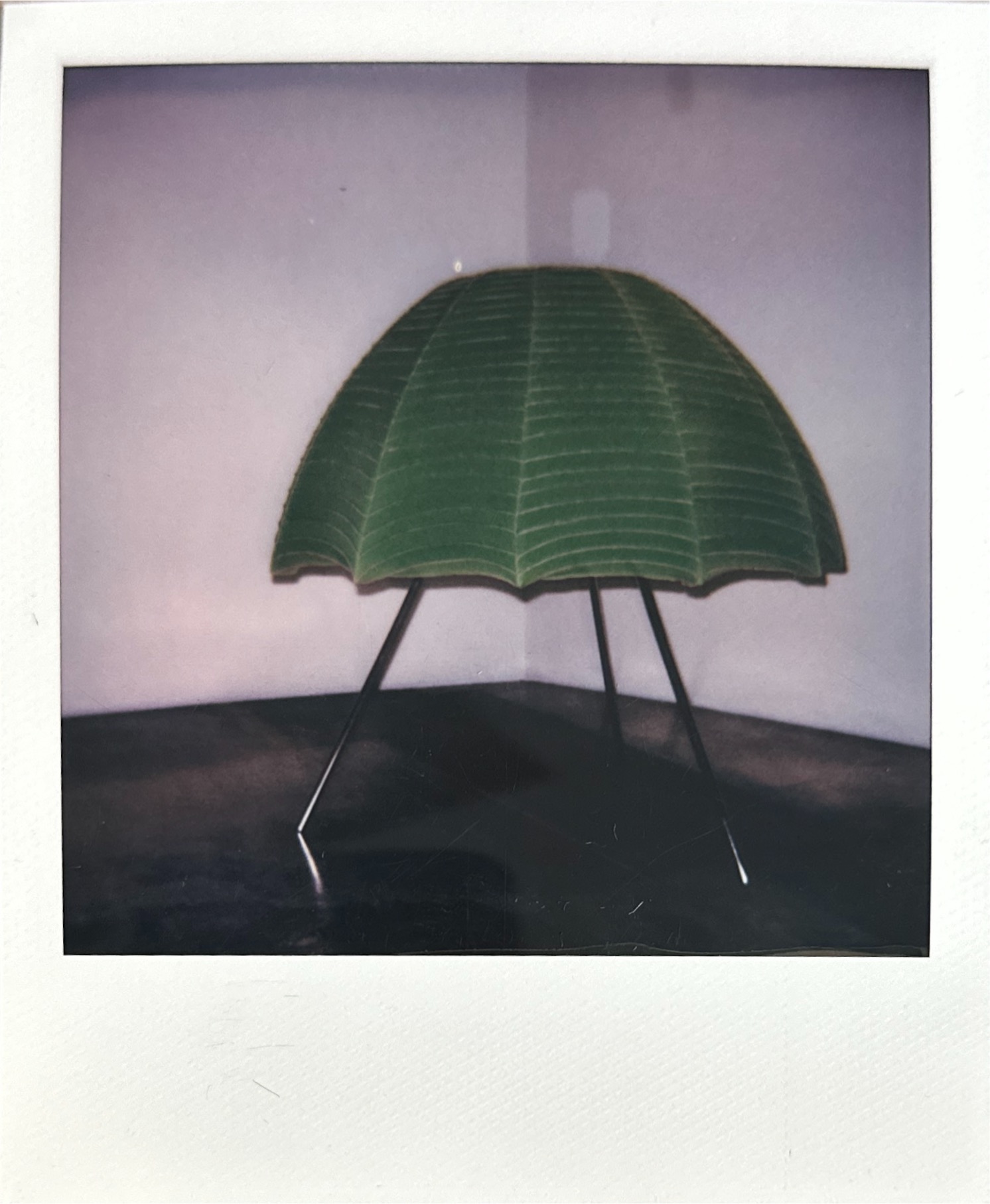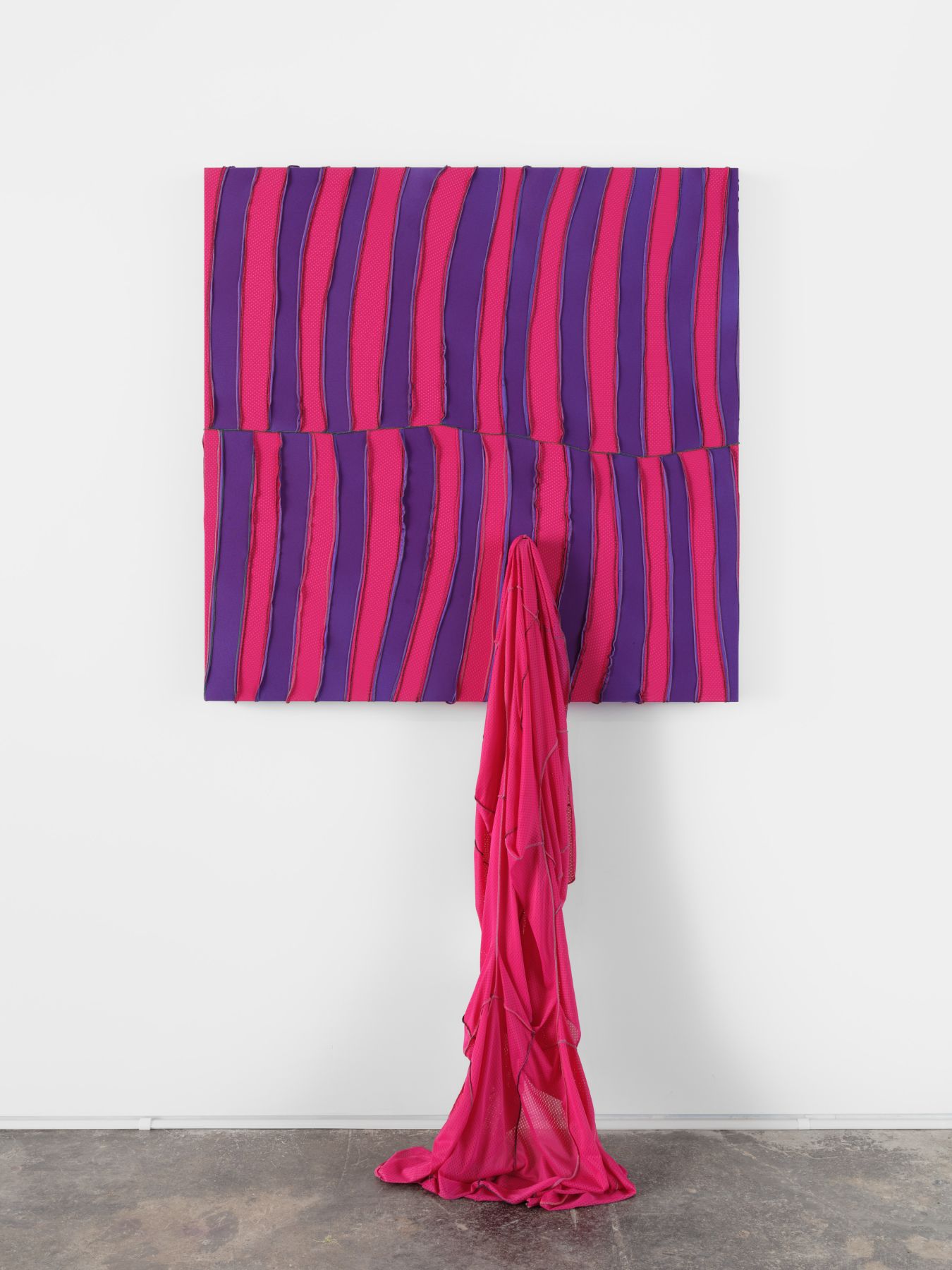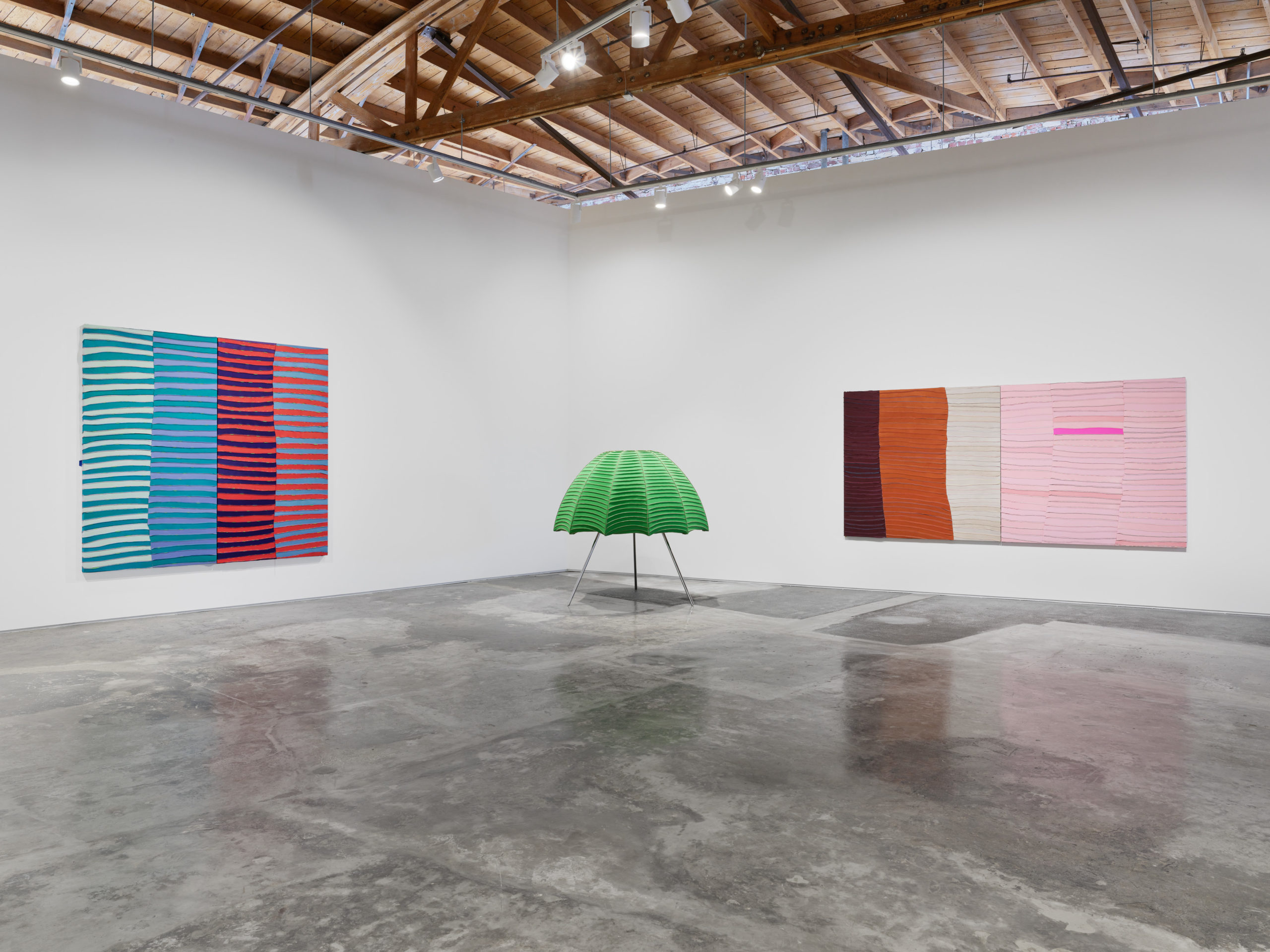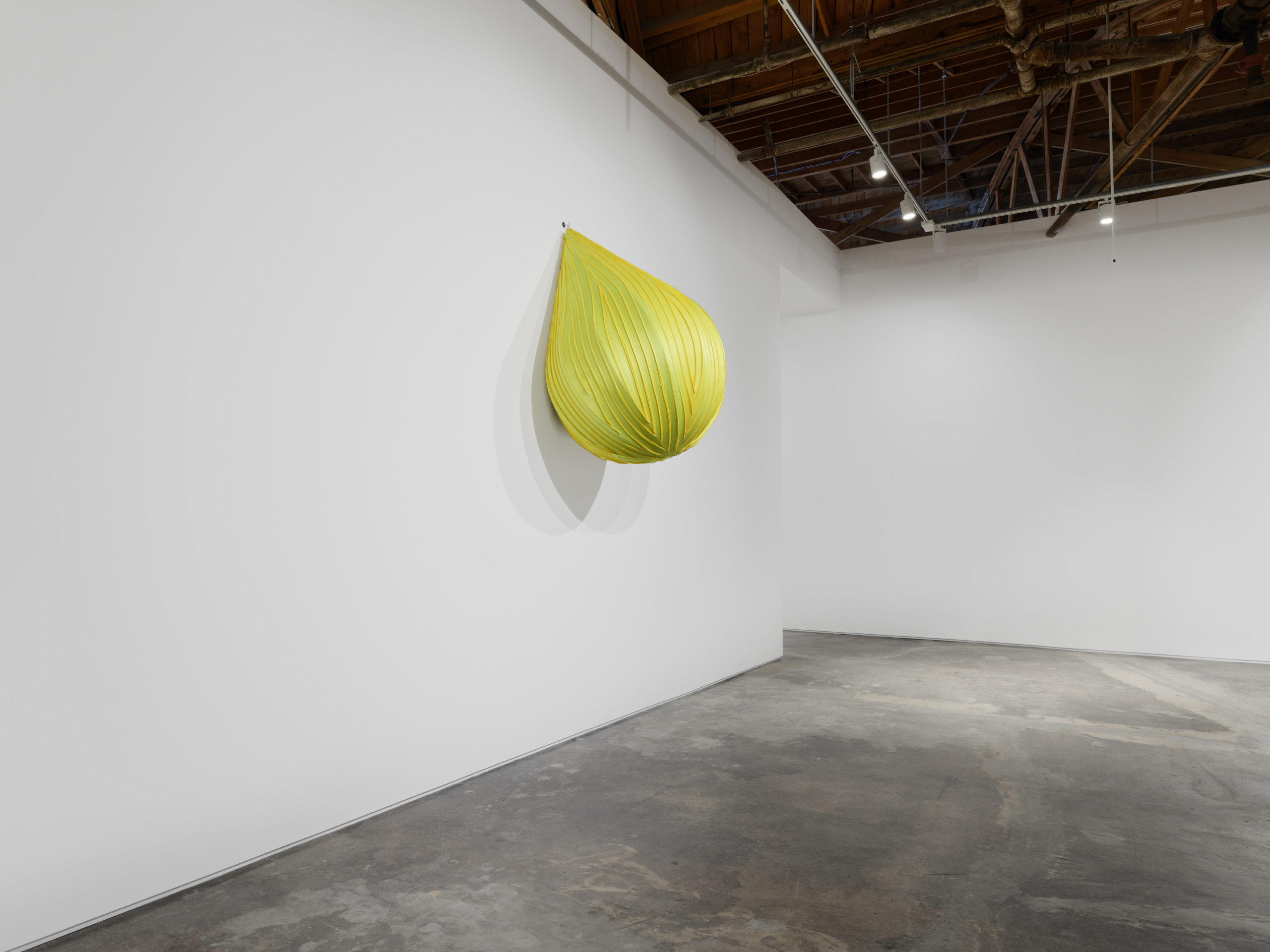For the Dispatches column, Kareema Thomas compares the dances of identity performed by the Nigerian-American musician known as DJ DBL D and the Nigerian-American artist Anthony Olubunmi Akinbola, framed by their common use of one cultural symbol: the durag.

Anthony Olubunmi Akinbola, Spinin, 2023. Durags on aluminum. 68 1/2 x 71 x 71 in. Courtesy of the artist and Night Gallery, Los Angeles Photo: Ulysses Murray.
I met DJ DBL D at an underground after-hours lounge in downtown Los Angeles. Before that, I only knew him as ‘Kechi, a Nigerian-American musician from Chicago, Illinois. And before that, I only knew him as a member of the Wahala Crew, a collective formed at the behest of DJ Major League. The Afrobeats club scene is one of the only places in Los Angeles where folks actually dance. The desire to move one’s body paired with the bravado of the headlining emcees, the coalescing of staccato bass and high-pitched bells ever present in amapiano, the crooning voice of Tems and the soothing swagger of Burna Boy makes a Saturday night at, say, Station 1640 an addictive experience. After moving to LA from New York, I sought out these unapologetically black spaces because they felt a lot like home.
As a newcomer to the Wahala Crew, DJ DBL D pays his dues. In any given lineup, he’s usually first, a crucial yet challenging time slot to occupy. Task: warm up the crowd for the night and ease them into the second shift, which is sure to be high energy. In the words of Fireboy DML, you’re responsible for making the “party scatter.” For ‘Kechi, a classically trained maestro, DJing is a departure from an oeuvre focused on producing and songwriting. He birthed DJ DBL D to break up the monotony of composing and rebrand himself. In this evolution, DJ DBL D considers the multiple ways he shows up—from his mixing decisions to his appearance. And he does all this in a durag.

Anthony Olubunmi Akinbola, Sweet Tooth, installation view, Night Gallery, Los Angeles, March 25–April 29, 2023. Courtesy of the artist and Night Gallery, Los Angeles. Photo: Marten Elder.
Cut to the Arts District in downtown Los Angeles. The durag is, again, on the proverbial stage. This time, it is in Sweet Tooth—the artist Anthony Olubunmi Akinbola’s second exhibition at Night Gallery (on view from March 25–April 29, 2023). Akinbola’s CAMOUFLAUGE series (2016–present) revolves around crafting abstract “paintings” from stretched durags, presenting them in their raw form—polyester fabric head coverings with distinct tails, often arranged monochromatically and pulled across aluminum frames. In Sweet Tooth, although its presence is more understated, the durag remains a primary material.
DJ DBL D and Akinbola are both of Nigerian-American descent. Through their parallel use of the durag, both negotiate Black identity within spaces of gathering and convening. The durag, initially designed to protect and maintain Black hairstyles, has evolved within the Black diaspora to signify identity, pride, and a rejection of Eurocentric beauty standards.
At present, ‘Kechi (or DJ DBL D) dons the durag in spaces like nightclubs to embody his own identity and transformation from classical musician to DJ. However, this experimentation began during his senior year at Northwestern University in 2019 when the durag was popular among his fellow Black classmates. A son of immigrants straddling both Nigerian and Black American identities, ‘Kechi embraced the durag and the associated “360 waves” hairstyle as a means to reconcile his multifaceted self. Akinbola alludes to the same theme of blending identities across life and art. We can interpret his commentary on the durag’s history as closely tied to assimilation, especially when considering the title of his CAMOUFLAUGE series. Akinbola confronts his own use of the durag, telling an interviewer: “If I were to put a durag on, maybe my Africanness would be forgotten. There’s something about wearing a durag that’s very Black American. And that’s a whole conversation, what we see as American, what’s in that palette. On the flipside, you lose your identity, you become a stereotypical threat.” Akinbola must contemplate the consequences of deliberate self-placement as he moves between distinct contexts: Black American life, Nigerian heritage, the artist’s studio, and the exhibition space. What identities might be gained? What might be sacrificed?

Anthony Olubunmi Akinbola, Guess This Flavor, 2023. Durags on aluminum and wood frame, 88 x 48 x 7 1/2 in. Courtesy of the artist and Night Gallery, Los Angeles. Photo: Nik Massey.
Akinbola’s formal metamorphosis of the durag deftly channels these traversals. One moment, Akinbola himself dons the durag; the next, he’s pulling, stretching, and reimagining the fabric. In Sweet Tooth, the artist dissects the durag into modular strips. Akinbola’s manipulation of the durag can be seen as a type of cultural translation, echoing the insights of Stuart Hall, who observed in “Creolité and the Process of Creolization” that “translation always bears the traces of the original, but in such a way that the original is impossible to restore.” In this process, the durag’s morphs between function and symbolism reflect the nuances and paradoxes that attend the abstraction of identity. This interplay is really a play of différance that resists the binary in favor of a spectrum. The durags in the CAMOUFLAUGE works are identifiable, layered, dangling, which materially speaks to the push-pull one experiences when navigating a multiplicity of selves. When the durags are reduced to flattened strips of fabric, what type of camouflage is at play?
Sweet Tooth looks like a scene from the circus. There are two claw machines. Toy Chest (2023) lies dormant, offering no interactivity. Instead, visitors are met with the disquieting sight of a grinning clown’s face perched inside the contraption, seemingly afloat amid a trove of balls. The durag paintings lining the walls shift the tone from grimace to gaiety. The swirling, brightly colored lines in Rumspringa’ (2023) evoke memories of the twirling stages from the “greatest show on Earth.” This nostalgia extends not only to the visual experience of the durag’s treatment, but also to the materiality of the works themselves, drawing parallels to the tactile and confectionery delights found under the big top. Most of the paintings, except Absolution and Guess That Flavor, omit the tails by which the durag is usually secured on one’s head. The cut up, rectangular swatches of fabric translate the durag into an expressive stripe, which formally echoes the abstract brushwork of Morris Louis and Sean Scully. The control of the monochrome lines patterned in freeform directions offers a commentary on abstraction, marrying the familiar line form with a sense of play and curiosity.
At every tier of interpretation, when engaging with Sweet Tooth, one’s focus gravitates toward the persistent duality that forms the essence of Akinbola’s work. He provides a materialistic lens through which we can reevaluate the carnival, not only as a physical space but also as a visual spectacle. Drawing inspiration from Mikhail Bakhtin’s theorizations of carnival, Akinbola seamlessly brings moments of temporal and spatial disfigurement into his artistic wheelhouse. What results is a subversion of societal conventions; we’re caught between regarding the material as a durag or something else.

Left: Anthony Olubunmi Akinbola, Shame, 2023. Durags on aluminum and wood frame, 96 x 96 in. Center: Anthony Olubunmi Akinbola, Spinin, 2023. Durags on aluminum. 68 1/2 x 71 x 71 in. Right: Anthony Olubunmi Akinbola, Neapolitan, 2023. Durags on aluminum and wood frame, 71 3/4 x 144 in. Installation view, Sweet Tooth, Night Gallery, Los Angeles, March 25–April 29, 2023. Courtesy of the artist and Night Gallery, Los Angeles. Photo: Marten Elder.
Amid the array of Akinbola’s creations, one particular piece, Spinin’, commands undivided attention. This nonfunctional, three-legged structure, wrapped in vibrant, verdant durags, stands in stark isolation. Spinin’ assumes the form of an oversized umbrella, with the customary eight panels and curvature designed to shield against the elements. However, upon closer examination, the work takes on the character of an awning similar to those commonly found adorning New York City bodegas. The stripes of polyester exhibit variations in both thickness and direction, imparting a sense of visual and chronological disarray. The title plays on the visual journey of these distorted lines, an illusion of motion, similar to the swirling patterns seen in dance. This title also engages in a subtle nod to “waves spinning,” a phrase associated with the “360 waves” or “waves,” where smooth, undulating patterns rotate around the scalp. Much like the mesmerizing charm of “360 waves,” akin to the entrancing energy of the Afrobeats club scene, Spinin’ invokes a perpetual sense of motion and vitality.
To fully immerse yourself in Spinin’, you must circle the work completely. Conversely, Lemon Drop (2023) presents a striking counterpoint to the bodily route of Spinin’. Suspended from a single carabiner attached to the wall, the canary-yellow structure presents viewers with various angles, particularly from below. From this vantage point, now limited to 180 degrees, the observer is granted a distinctive perspective. The oscillating lines and seams, subtle in the frontal view, now take center stage as prominent features, offering insight into the work’s craftsmanship and inviting viewers to explore the conceptual depths of its construction. Look, but don’t touch. Lemon Drop maintains its intrinsic bodily and haptic quality in both the informed awareness of one’s body when viewing the work and its encouraging tactile exploration (look but don’t touch!), both prompting a reevaluation of the material’s value and meaning.
Akinbola places us strategically within his fête. We are asked to inversely reconsider what value and meaning can exist through materiality and its manipulation. Are we active participants in extending the durag’s meaning? Do we assume this role in what feels like a gamified viewing experience, where, as per the rules of carnival, our transgressions become the norm?

Anthony Olubunmi Akinbola, Lemon Drop, 2023. Durags on wood frame, 72 x 48 x 48 in. Installation view, Sweet Tooth, installation view, Night Gallery, Los Angeles, March 25–April 29, 2023. Courtesy of the artist and Night Gallery, Los Angeles. Photo: Marten Elder.
For Akinbola, adorning an aluminum armature with the durag as a readymade—leveraging its materiality and contextual meaning(s)—becomes a matter of consumption, spectatorship, Black identity, and, by extension, labor and waste. Between ‘Kechi and Akinbola, the public appliqué of the durag on human flesh or aluminum frame introduces a question about the multiplicity of selves. I believe both men ask us to reconsider our own understanding of depictions of black men in durags, beyond known contexts. Akinbola poses this logic by omitting the durag tails and, indeed, the Black male figure entirely. Where is the Black person—‘Kechi, Akinbola—in Sweet Tooth? Is the presence of the durag a form of camouflage—another hailing or interpellation of an entertainer, a stand-in for the Black male form, positioned squarely for the viewer’s inspection? Is the carnivalesque scene a more palatable entry point to begin wrestling with the often fraught nuances that Black men in durags encounter when occupying public space? These questions mark the precipice where things begin to fall apart. X

Kareema Thomas is a Los Angeles-based arts curator and writer. Her research orbits the intersection of architecture and the nuanced experiences of black and brown communities. Actively investigating non-conventional architectural forms in books, film, and new media, she accentuates spatial experiences, site specificity, and the performative nuances of narrative retelling.